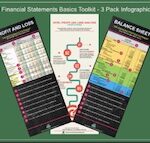Long Term Liabilities - Are Earnings Covering Your Loan Obligations?
As a hotel manager, would you know if your hotel is struggling with long term liabilities.
In particular, paying back interest and loan installments is often a struggle.
Why is it a struggle you ask?
Well, if your revenue generation is under strain, consequently, your cash flow is also under stress.
With a poor cash flow, paying back loan obligations is a challenge.
I will lay out a case first, for knowing whether your long term liabilities are under control.
We will first see some examples of long term liabilities in the hotel balance sheet.
Grab this EXCEL Spreadsheet
Don’t miss our 5 Killer Hotel KPIs Dashboard
Get this exclusive Excel Template that you can customize to create your own 5 Killer Hotel KPIs Dashboard
Then I will suggest some measures to keep that situation going consistently.
If you are a general manager, it will be even more critical that you are on top of this.
Your owners will want to ensure that you are on top of this situation.
This Chapter 5 of Ultimate Guide on Hotel Balance Sheet Basics will cover:
What Your Business Owes as Long Term Liabilities
You saw in earlier chapters that if Assets are What the Business Owns, Liabilities are What the Business OWES.
[If you missed earlier chapters of this Ultimate Guide on Hotel Balance Sheet Basics, see below to read them]
Liabilities are what the business owes to outside parties.
In other words, liabilities are claims that outside parties have on the business for two principal reasons:
- goods delivered or
- services rendered
or both.
Actually in the context of a hotel, it is both these reasons.
So, what is a liability you ask?
Great question.
Let us understand how liabilities and more specifically long term liabilities work.
The Expenses - Liability Connection
When you:
- incur expenditure for the business but
- DO NOT PAY FOR IT IMMEDIATELY,
you are creating a liability for the business.
Simply put, it means you will have to pay later, normally 30 days later.
So, liabilities are expenses incurred but not YET paid for.
In a nutshell, you could say that expenses are generally incurred:
- by immediately paying cash or
- by creating a liability to pay for later.
Liabilities are the Risk Factor
Because liabilities:
- represent claims that outside parties have on the business
- for payment of their goods and services,
- they constitute risk for the business.
Liabilities can thus be considered an index of risk for the business.
How does this risk show itself in business?
When businesses:
- incur expenditure by creating liabilities but
- are not able to pay them back,
- the business is at risk of being shut down (in extreme cases).
It is important to understand that it is:
- the inability to pay liabilities over a certain period of time,
- say continuously for six months
- that may lead to shut down.
It is particularly topical in this current post pandemic era.
Many smaller hotel establishments folded up due to inability to pay loans.
Why were they unable to pay back loans during the pandemic?
Because revenue generation suffered greatly during the pandemic.
This was the result of lockdowns and freeze on travel.
When revenue falls drastically, it first affects cash inflow.
When Cash inflow is under strain, the establishment begins to default in its long term liabilities or loan obligations.
Just like assets, Liabilities may be short term or long term.
Short term liabilities are those which are payable within a period of 12 months.
These are known as Current Liabilities.
You read about this in Chapter 3 of this Ultimate Guide on Hotel Balance Sheet Basics.
Click here if you missed that.
Long term liabilities are those that are payable after 12 months.
They are often called Long Term Debt or just Debt in a Balance Sheet (see Paradise Hotel Balance Sheet below).

Long Term Liabilities or Debt of Paradise Hotel
Liabilities are related to cash outflow.
In other words, these are payable in cash and the business has to plan for and arrange that.
Examples of Long Term Liabilities
Let us see some examples of long term liabilities in the Paradise Hotel Balance Sheet.
Mortgage Payable
Long term liabilities are normally Term loans payable to banks or financial institutions.
This is shown in the above balance sheet of Paradise Hotel as Mortgage Payable.
A Term Loan is an amount borrowed by the hotel for a particular term.
Term Loans are borrowings that are secured by the hotel’s assets.
In other words, term loans are secured by a mortgage of hotel assets.
What it means is, that:
- if the hotel defaults in payment of its loan installment or interest obligations,
- the lender can apply foreclosure.
Foreclosure is a process that happens when the hotel is found to be unable to pay its loans over time.
The lender thus takes charge of the hotel assets to recover the amount of the outstanding loan.
In North America, the standard loan period for a mortgage is 30 years.
In the Balance Sheet of Paradise Hotel shown above, you can see the Term Loan is stated as Mortgage Payable.
Debt Equity Ratio - Measuring Long Term Liabilities
A hotel (like any other business establishment) will look to borrow money for acquiring assets.
Acquiring assets is for the purpose of generating revenue.
Acquiring assets for a new hotel will include constructing the hotel itself.
A hotel establishment may broadly look for two sources of finance:
- Its own funds or what is known as Equity (often it is through a public subscription)
- Borrowed funds
In Chapter 5 of this Ultimate Guide on Hotel Balance Sheet Basics, we will get to understand how debt and equity are measured for risk assessment.
Interest Coverage Ratio and Long Term Liabilities
Long Term Liabilities generally and Loans more specifically bring in another critical obligation.
It is the obligation to make regular payments of interest for the loans borrowed.
As stated earlier, if revenue is under strain like during the pandemic, cash flow falls drastically.
This may lead to defaulting in interest payments.
So, how do you measure whether your hotel business is safe as far as interest payment obligations go?
Great question.
It is by calculating what is known as the Interest Coverage Ratio (see image and ratio below)

Interest Coverage Ratio
Interest Coverage Ratio is one of the most important Financial Ratios related to liabilities.
This ratio calculates:
- the number of times
- a hotel’s Profit or Earnings Before Interest and Taxes
- covers the interest expense.
The higher the ratio, the more safe the hotel is in its interest obligations.
In this Ultimate Guide, we have seen current and long term assets, current and long term liabilities.
That covers all major categories in a hotel balance sheet except one.
And that is a big one.
Capital.
Or also known as Owner Equity.
In Chapter 6, we will see how capital or owner equity is central to a business.
We will also see how Debt Equity Ratio is measured.
And how a hotel can keep its balance sheet showing a sound financial position.
How about your hotel?
Have you ever asked to find out what your hotel owes in loan obligations?
Talk to your Financial Controller.
Meanwhile, you can take the following action steps immediately as laid out below.
Action Steps You can Take Right Now
STEP 1
Go to your Hotel Financial Controller and ask him to show you the Balance Sheet for the hotel.
STEP 2
Identify Long Term Liabilities in your hotel balance sheet and more specifically Mortgage Payable.
STEP 3
Notice how Mortgage Payable are laid out. What type of mortgage does your hotel have?
STEP 4
How much are Mortgage Payable for your hotel? Do you know how long are they outstanding for?
STEP 5
Ask yourself whether as a hotel manager you are managing your long term liabilities effectively.
Other Chapters of Ultimate Guide on Hotel Balance Sheet Basics
Sign Up for Speed Tips - Learn in Minutes!
Sign up to the Speed Tips Newsletter for more tips, strategies and secrets straight to your inbox.
11





